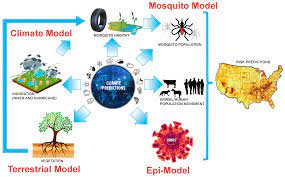CLIMATE CHANGE AND ITS IMPACT ON VECTOR POPULATION IN ANIMAL DISEASE TRANSMISSION
Mathivathani C* and Angeline Felicia Bora C*
*Assistant Professor, Department of Veterinary Parasitology, Rajiv Gandhi Institute of Veterinary Education and Research (RIVER), Puducherry -605009
(Email: mathivathani.c@river.edu.in)
Abstract:
Climate change profoundly impacts vector populations, altering disease transmission dynamics among animals. Rising temperatures expand the geographical range of vectors like mosquitoes and ticks, while shifting seasonal patterns disrupt their life cycles. Changes in precipitation and extreme weather events further modify vector habitats, influencing abundance and distribution. Consequently, animal populations face increased exposure to vector-borne pathogens, leading to heightened disease spread and the emergence of novel infections in new regions. Addressing these challenges demands interdisciplinary collaboration and proactive measures to mitigate the impacts of climate change on vector-borne disease transmission. Understanding these dynamics is essential for effective disease management and safeguarding animal health and welfare.
Keywords: Vector, climate change, animal, disease
Introduction:
Climate change is an undeniable reality with far-reaching consequences across the globe. One of its significant impacts is the alteration of ecosystems, including the distribution and abundance of various species. In particular, changes in temperature and precipitation patterns influence the population dynamics of vectors, such as mosquitoes and ticks, which play crucial roles in the transmission of diseases among animals (IPCC, 2014). Understanding these dynamics is essential for mitigating the spread of infectious diseases in both wildlife and domestic animals.
Effects of Climate Change on Vector Population:
- Temperature Rise and Vector Distribution:
As global temperatures rise, the geographical range of many vectors expands. Warmer climates allow vectors to thrive in regions previously unsuitable for their survival (Lafferty, 2009). For instance, certain mosquito species, like Aedes aegypti, responsible for transmitting diseases like dengue fever and Zika virus, are now found in more temperate regions due to warming temperatures.
- Altered Seasonal Patterns:
Climate change disrupts traditional seasonal patterns, affecting the life cycles of vectors. Changes in temperature and precipitation influence the timing of breeding, feeding, and hibernation for many vector species. As a result, the transmission dynamics of associated diseases may shift, leading to outbreaks occurring earlier or later in the year.
- Habitat Modification:
Shifts in precipitation patterns and the frequency of extreme weather events can alter vector habitats. For example, increased rainfall may create more breeding sites for mosquitoes, while droughts can lead to the concentration of vectors around remaining water sources. These changes in habitat availability directly impact the abundance and distribution of vectors and subsequently influence disease transmission dynamics.
Impact on Animal Disease Transmission:
- Increased Disease Spread:
Changes in vector abundance and distribution can facilitate the spread of infectious diseases among animals. Domestic livestock, wildlife populations, and even humans may experience heightened exposure to vector-borne pathogens as a result of climate-driven shifts in vector populations. This increased disease burden poses significant challenges for disease management and control efforts.
- Emerging Diseases:
Climate change can create opportunities for the emergence of novel vector-borne diseases in previously unaffected regions. As vectors expand their range into new territories, they may come into contact with susceptible host populations, leading to the transmission of pathogens that were once confined to specific geographical areas (Altizer et al, 2013). This scenario underscores the importance of monitoring and surveillance to detect and respond to emerging disease threats promptly.
Conclusion:
Climate change exerts profound effects on vector populations and, consequently, the transmission dynamics of diseases among animals. The interplay between environmental factors and vector biology shapes the epidemiology of vector-borne diseases, posing significant challenges for animal health and welfare. Addressing these challenges requires interdisciplinary collaboration, innovative research, and proactive measures to mitigate the impacts of climate change on vector-borne disease transmission.
References:
[1] Altizer, S., Ostfeld, R. S., Johnson, P. T., Kutz, S., & Harvell, C. D. (2013). Climate change and infectious diseases: from evidence to a predictive framework. Science, 341(6145), 514-519.
[2] IPCC. (2014). Climate Change 2014: Impacts, Adaptation, and Vulnerability. Contribution of Working Group II to the Fifth Assessment Report of the Intergovernmental Panel on Climate Change.
[3] Lafferty, K. D. (2009). The ecology of climate change and infectious diseases. Ecology, 90(4), 888-900.


